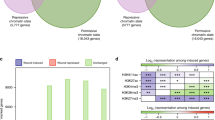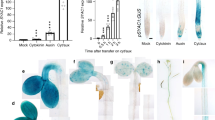Abstract
Wounding is the first event triggering regeneration1,2,3,4. However, the molecular basis of wound signalling pathways in plant regeneration is largely unclear. We previously established a method to study de novo root regeneration (DNRR) in Arabidopsis thaliana5,6, which provides a platform for analysing wounding. During DNRR, auxin is biosynthesized after leaf detachment and promotes cell fate transition to form the root primordium5,6,7. Here, we show that jasmonates (JAs) serve as a wound signal during DNRR. Within 2 h of leaf detachment, JA is produced in leaf explants and activates ETHYLENE RESPONSE FACTOR109 (ERF109). ERF109 upregulates ANTHRANILATE SYNTHASE α1 (ASA1)—a tryptophan biosynthesis gene in the auxin production pathway8,9,10—dependent on the pre-deposition of SET DOMAIN GROUP8 (SDG8)-mediated histone H3 lysine 36 trimethylation (H3K36me3)11 on the ASA1 locus. After 2 h, ERF109 activity is inhibited by direct interaction with JASMONATE-ZIM-DOMAIN (JAZ) proteins to prevent hypersensitivity to wounding. Our results suggest that a dynamic JA wave cooperates with histone methylation to upregulate a pulse of auxin production and promote DNRR in response to wounding.
This is a preview of subscription content, access via your institution
Access options
Access Nature and 54 other Nature Portfolio journals
Get Nature+, our best-value online-access subscription
$29.99 / 30 days
cancel any time
Subscribe to this journal
Receive 12 digital issues and online access to articles
$119.00 per year
only $9.92 per issue
Buy this article
- Purchase on Springer Link
- Instant access to full article PDF
Prices may be subject to local taxes which are calculated during checkout




Similar content being viewed by others
Data availability
The data that support the findings of this study are available from the corresponding author upon request.
References
Chen, L., Sun, B., Xu, L. & Liu, W. Wound signaling: the missing link in plant regeneration. Plant Signal. Behav. 11, e1238548 (2016).
Ikeuchi, M. et al. Wounding triggers callus formation via dynamic hormonal and transcriptional changes. Plant Physiol. 175, 1158–1174 (2017).
Birnbaum, K. D. & Sanchez Alvarado, A. Slicing across kingdoms: regeneration in plants and animals. Cell 132, 697–710 (2008).
Xu, L. & Huang, H. Genetic and epigenetic controls of plant regeneration. Curr. Top. Dev. Biol. 108, 1–33 (2014).
Liu, J. et al. WOX11 and 12 are involved in the first-step cell fate transition during de novo root organogenesis in Arabidopsis. Plant Cell 26, 1081–1093 (2014).
Xu, L. De novo root regeneration from leaf explants: wounding, auxin, and cell fate transition. Curr. Opin. Plant Biol. 41, 39–45 (2018).
Chen, L. et al. YUCCA-mediated auxin biogenesis is required for cell fate transition occurring during de novo root organogenesis in Arabidopsis. J. Exp. Bot. 67, 4273–4284 (2016).
Niyogi, K. K. & Fink, G. R. Two anthranilate synthase genes in Arabidopsis: defense-related regulation of the tryptophan pathway. Plant Cell 4, 721–733 (1992).
Sun, J. et al. Arabidopsis ASA1 is important for jasmonate-mediated regulation of auxin biosynthesis and transport during lateral root formation. Plant Cell 21, 1495–1511 (2009).
Cai, X. T. et al. Arabidopsis ERF109 mediates cross-talk between jasmonic acid and auxin biosynthesis during lateral root formation. Nat. Commun. 5, 5833 (2014).
Zhao, Z., Yu, Y., Meyer, D., Wu, C. & Shen, W. H. Prevention of early flowering by expression of FLOWERING LOCUS C requires methylation of histone H3 K36. Nat. Cell Biol. 7, 1256–1260 (2005).
Da Costa, C. T. et al. When stress and development go hand in hand: main hormonal controls of adventitious rooting in cuttings. Front. Plant Sci. 4, 133 (2013).
Druege, U., Franken, P. & Hajirezaei, M. R. Plant hormone homeostasis, signaling, and function during adventitious root formation in cuttings. Front. Plant Sci. 7, 381 (2016).
Ahkami, A. H. et al. Molecular physiology of adventitious root formation in Petunia hybrida cuttings: involvement of wound response and primary metabolism. New Phytol. 181, 613–625 (2009).
Fattorini, L. et al. Adventitious rooting is enhanced by methyl jasmonate in tobacco thin cell layers. Planta 231, 155–168 (2009).
Lischweski, S., Muchow, A., Guthorl, D. & Hause, B. Jasmonates act positively in adventitious root formation in petunia cuttings. BMC Plant Biol. 15, 229 (2015).
Monte, I. et al. Rational design of a ligand-based antagonist of jasmonate perception. Nat. Chem. Biol. 10, 671–676 (2014).
Wang, Z. et al. Identification and characterization of COI1-dependent transcription factor genes involved in JA-mediated response to wounding in Arabidopsis plants. Plant Cell Rep. 27, 125–135 (2008).
Berr, A. et al. Arabidopsis histone methyltransferase SET DOMAIN GROUP8 mediates induction of the jasmonate/ethylene pathway genes in plant defense response to necrotrophic fungi. Plant Physiol. 154, 1403–1414 (2010).
Li, Y. et al. The histone methyltransferase SDG8 mediates the epigenetic modification of light and carbon responsive genes in plants. Genome Biol. 16, 79 (2015).
Thines, B. et al. JAZ repressor proteins are targets of the SCF(COI1) complex during jasmonate signalling. Nature 448, 661–665 (2007).
Chini, A. et al. The JAZ family of repressors is the missing link in jasmonate signalling. Nature 448, 666–671 (2007).
Kazan, K. & Manners, J. M. JAZ repressors and the orchestration of phytohormone crosstalk. Trends Plant Sci. 17, 22–31 (2012).
Bahieldin, A. et al. Multifunctional activities of ERF109 as affected by salt stress in Arabidopsis. Sci. Rep. 8, 6403 (2018).
Bahieldin, A. et al. Ethylene responsive transcription factor ERF109 retards PCD and improves salt tolerance in plant. BMC Plant Biol. 16, 216 (2016).
Kong, X. et al. PHB3 maintains root stem cell niche identity through ROS-responsive AP2/ERF transcription factors in Arabidopsis. Cell Rep. 22, 1350–1363 (2018).
Gutierrez, L. et al. Auxin controls Arabidopsis adventitious root initiation by regulating jasmonic acid homeostasis. Plant Cell 24, 2515–2527 (2012).
Xu, L. et al. The SCFCOI1 ubiquitin-ligase complexes are required for jasmonate response in Arabidopsis. Plant Cell 14, 1919–1935 (2002).
Yang, L. et al. Pseudomonas syringae type III effector HopBB1 promotes host transcriptional repressor degradation to regulate phytohormone responses and virulence. Cell Host Microb. 21, 156–168 (2017).
Murashige, T. & Skoog, F. A revised medium for rapid growth and bioassays with tobacco tissue culture. Physiol. Plant. 80, 662–668 (1962).
Chen, X. et al. A simple method suitable to study de novo root organogenesis. Front. Plant Sci. 5, 208 (2014).
Gamborg, O. L., Miller, R. A. & Ojima, K. Nutrient requirements of suspension cultures of soybean root cells. Exp. Cell Res. 50, 151–158 (1968).
Mao, Y. B. et al. Jasmonate response decay and defense metabolite accumulation contributes to age-regulated dynamics of plant insect resistance. Nat. Commun. 8, 13925 (2017).
Sun, L.-J. et al. Electrochemical mapping of indole-3-acetic acid and salicylic acid in whole pea seedlings under normal conditions and salinity. Sens. Actuators B Chem. 276, 543–551 (2018).
Sun, L.-J. et al. Paper-based analytical devices for direct electrochemical detection of free IAA and SA in plant samples with the weight of several milligrams. Sens. Actuators B Chem. 247, 336–342 (2017).
He, C., Chen, X., Huang, H. & Xu, L. Reprogramming of H3K27me3 is critical for acquisition of pluripotency from cultured Arabidopsis tissues. PLoS Genet. 8, e1002911 (2012).
Li, G. et al. ISWI chromatin remodeling factors and their interacting RINGLET proteins act together in controlling the plant vegetative phase in Arabidopsis. Plant J. 72, 261–270 (2012).
Xu, L. et al. Di- and tri- but not monomethylation on histone H3 lysine 36 marks active transcription of genes involved in flowering time regulation and other processes in Arabidopsis thaliana. Mol. Cell Biol. 28, 1348–1360 (2008).
Bolger, A. M., Lohse, M. & Usadel, B. Trimmomatic: a flexible trimmer for Illumina sequence data. Bioinformatics 30, 2114–2120 (2014).
Langmead, B., Trapnell, C., Pop, M. & Salzberg, S. L. Ultrafast and memory-efficient alignment of short DNA sequences to the human genome. Genome Biol. 10, R25 (2009).
Dobin, A. et al. STAR: ultrafast universal RNA-Seq aligner. Bioinformatics 29, 15–21 (2013).
Li, B. & Dewey, C. N. RSEM: accurate transcript quantification from RNA-Seq data with or without a reference genome. BMC Bioinformatics 12, 323 (2011).
Kumar, L. & M, E. F. Mfuzz: a software package for soft clustering of microarray data. Bioinformation 2, 5–7 (2007).
Leng, N. et al. EBSeq: an empirical Bayes hierarchical model for inference in RNA-Seq experiments. Bioinformatics 29, 1035–1043 (2013).
Zhang, Y. et al. Model-based analysis of ChIP-Seq (MACS). Genome Biol. 9, R137 (2008).
Stark, R. & Brown, G. DiffBind: differential binding analysis of ChIP-Seq peak data (Cancer Research UK, 2018).
Thorvaldsdottir, H., Robinson, J. T. & Mesirov, J. P. Integrative Genomics Viewer (IGV): high-performance genomics data visualization and exploration. Brief. Bioinform. 14, 178–192 (2013).
Acknowledgements
We thank the ABRC, Z. Zhu, G. A. Howe and D. Xie for providing the Arabidopsis seeds, Z. Zhu and W. Zhou for helpful discussion, Y. Liu from the Core Facility Centre of SIPPE for technical assistance on JA detection, and J. Pan and D. Cai for help on auxin concentration analysis. This work was supported by grants from the National Natural Science Foundation of China (31630007, 31770399 and 21375066), Strategic Priority Research Program of CAS (grant number XDB27030103), Key Research Program of CAS (QYZDB-SSW-SMC010), Youth Innovation Promotion Association of CAS (2014241 and 2014230) and National Key Laboratory of Plant Molecular Genetics.
Author information
Authors and Affiliations
Contributions
G.Z., L.C. and L.X. designed the research. G.Z., F.Z. and Y.Z. performed the RNA-seq and ChIP-seq analyses. G.Z., Y.P., L.S. and N.B. analysed the auxin concentration. C.-X.C. and Z.Q. synthesized the COR-MO. L.Y. performed the Co-IP. G.Z., L.C. and T.Z performed the other experiments. G.Z., F.Z., L.Y. and L.X. analysed the data. L.X. wrote the article.
Corresponding author
Ethics declarations
Competing interests
The authors declare no competing interests.
Additional information
Journal peer review information: Nature Plants thanks Jian Xu and the other anonymous reviewers for their contribution to the peer review of this work.
Publisher’s note: Springer Nature remains neutral with regard to jurisdictional claims in published maps and institutional affiliations.
Supplementary information
Supplementary Information
Supplementary Figures 1–7 and Supplementary Table 2.
Supplementary Table 1
List of cluster-1 to -10 genes and JA- and auxin-related genes.
Rights and permissions
About this article
Cite this article
Zhang, G., Zhao, F., Chen, L. et al. Jasmonate-mediated wound signalling promotes plant regeneration. Nat. Plants 5, 491–497 (2019). https://doi.org/10.1038/s41477-019-0408-x
Received:
Accepted:
Published:
Issue Date:
DOI: https://doi.org/10.1038/s41477-019-0408-x
This article is cited by
-
Integrated transcriptome and DNA methylome analysis reveal the biological base of increased resistance to gray leaf spot and growth inhibition in interspecific grafted tomato scions
BMC Plant Biology (2024)
-
Temporal profiling of physiological, histological, and transcriptomic dissection during auxin-induced adventitious root formation in tetraploid Robinia pseudoacacia micro-cuttings
Planta (2024)
-
WOX11: the founder of plant organ regeneration
Cell Regeneration (2023)
-
Ethylene signals modulate the survival of Arabidopsis leaf explants
BMC Plant Biology (2023)
-
RWP-RK Domain 3 (OsRKD3) induces somatic embryogenesis in black rice
BMC Plant Biology (2023)



